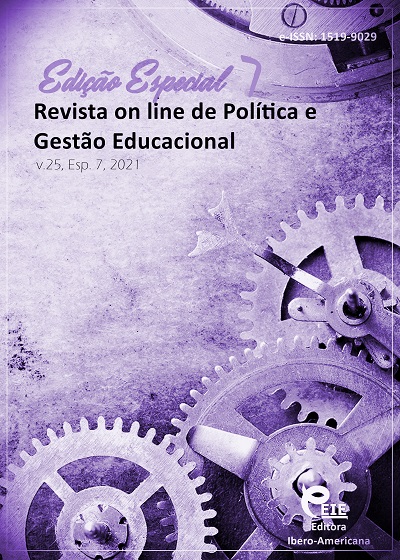Rumo a um modelo multinível de educação profissional e técnica contínua
DOI:
https://doi.org/10.22633/rpge.v25iesp.7.16149Palavras-chave:
Disciplinas acadêmicas fundamentais, Disciplinas gerais de engenharia, Orientação profissional, Modelo metodológicoResumo
O objetivo do estudo é desenhar um sistema científico e metodológico dirigido profissionalmente. O desenho da estrutura e do conteúdo das disciplinas acadêmicas fundamentais é realizado a partir do exemplo da física, que é fundamental na formação de engenheiros - eletricistas, engenheiros de potência, eletromecânica e eletrônica. Para o desenho da estrutura de planejamento da formação, foram escolhidos os seguintes métodos de pesquisa: orientação profissional da formação, quando o núcleo formador do sistema de formação é a direção da formação, a futura especialidade; princípio da relação integrativa de todas as disciplinas acadêmicas educacionais entre a definição e protagonismo de disciplinas acadêmicas especiais ou bloco de disciplinas acadêmicas especiais. Na concepção de um sistema científico e metodológico de formação profissionalmente direcionada em disciplinas acadêmicas, estabelecem-se as principais disposições conceptuais de um sistema de disciplinas teóricas gerais, com base no modelo desenhado de formação profissionalmente direcionado em disciplinas teóricas acadêmicas gerais.
Downloads
Referências
ABDEEV, R. F. Philosophy of information civilization. Moscow, 1994.
BAKHAREV, N. P.; LAVRENINA, A. N. Workshop on solving electrodynamic problems. Togliatti: TolPI, 1999.
BASHISHEVA, S. YA. (Ed.). Professional pedagogy. Moscow: Professional education, 1997. 512 p.
BELYAEVA, A. P. Integration of vocational training. Sov. Pedagogy, 1987.
DAVYDOV, V. V. Types of generalization in teaching (logical and psychological problems of the construction of educational subjects). Moscow: Pedagogy, 1972.
DVOYASHKIN, N. K.; KABIROV, R. R.; NOVIKOVA, A. KH. Forms and methods of teaching a course in general physics in a technical university of oil profile. Humanitarium, v. 2, n. 7, p. 22-25, 2018.
FIRSTOV, D. S. Features of teaching physics (natural science) for managers at an engineering physics university. Physical education in universities, v. 23, n. 2, 74-87, 2017.
GALEEV, I. G.; SHAKIROV, A. S. Some aspects of teaching physics for undergraduate technical students. Science in motion: from reflection to creation of reality. In: GARIFULLINA, M. S. (Ed.). Materials of the all-russian scientific and practical conference. 2016. p. 385-388.
IBATOVA, A. Z. Development of a criteria apparatus for assessing the students' readiness for a dialogue in general and business sphere. Universidad y Sociedad, v. 12, n. 2, p. 48-52. 2020.
KALACHEV, N. V. et al. Practical aspects of increasing the level of knowledge in physics among schoolchildren planning to enroll in technical universities. Modern Physics Practicum, v. 14, p. 25-27, 2016.
KHOLINA, S. A. The concept of an educational and methodological kit on the theory and methods of teaching physics. Pedagogical education and science, v. 5, p. 68-71, 2019.
KORNEV, G. P.; BAKHAREV, N. P.; TAMER, O. S. Methodological features of studying complex numbers based on interdisciplinary connections of mathematics and physics. Special course for professional physical and mathematical training of students of technical universities. Togliatti: TolPI, 1999. cap. 109.
KUSTOV, YU. A.; BAKHAREV, N. P.; VORONIN, V. N. Continuity in the system of continuous education. Textbook. allowance. Togliatti: TolPI, Volga University named after V.N. Tatishcheva, 1999.
LARIONOV, V. V.; VERNIGORA, A. M.; CHERKASOVA, M. A. Cognitive and innovative training of students in teaching physics at a technical university. Bulletin of the Tomsk State Pedagogical University, v. 6, n. 147, p. 60-63, 2014.
MANSUROVA, S. E. Some aspects of teaching a physics course in the magistracy of the Mining University. Modern education: content, technology, quality, v. 1, p. 167-169, 2019.
NECHAEV, N. N. Psychological and pedagogical foundations of the formation of professional activity. Moscow: Publishing house of Moscow State University, p. 166, 1988.
PAK, V. V. Design potential of physical problems and its diagnostics in teaching physics to students of technical universities. Scientific and pedagogical review, v. 2, n. 12, p. 103-107, 2016.
POSTNIKOVA, E. I.; LISICHKO, E. V.; KRAVCHENKO, N. S. Teaching physics at a technical university in the electronic environment MOODLE. Innovative technologies in science and education, v. 2, n. 6, p. 194-198, 2016.
SULTANALIEVA, G. M.; KOSHARNAYA, A. V. Comparative analysis of the system of professional training of specialists in the direction of "Electric power and electrical engineering" in a technical university. Industrial energy, v. 9, p. 52-60, 2020.
TRYNKINA, E. T.; MOKROVITSKAYA, N. V. New approaches to teaching physics and chemistry at a technical university. Training and Upbringing: Methods and Practice of The 2016/2017 Academic Year. In: BLACK-VA, S.S. (Ed.). Collection of materials of the XXXIII International Scientific and Practical Conference. 2017. p. 161-168.
VELIKOVICH, L. L. Physics and Mathematics at a Technical University: Together or Apart. Actual Problems and Prospects of Teaching Mathematics. In: Collection of Scientific Articles of the V International Scientific and Practical Conference. Ministry of Education and Science of the Russian Federation; Southwest State University, 2014. p. 21-32.
VISHNEVSKY, L. I.; ARTYUSHKINA, L. M. Application of logical structures of educational material in teaching physics. Physics at school, v. 1, 1981.
ZAGVYAZINSKY, V. I. Higher school didactics. Lecture text. Chelyabinsk: CPI, 1990.
Downloads
Publicado
Como Citar
Edição
Seção
Licença
Copyright (c) 2022 Revista on line de Política e Gestão Educacional

Este trabalho está licenciado sob uma licença Creative Commons Attribution-NonCommercial-ShareAlike 4.0 International License.
Manuscritos aceitos e publicados são de propriedade da Revista on line de Política e Gestão Educacional. É vedada a submissão integral ou parcial do manuscrito a qualquer outro periódico. A responsabilidade do conteúdo dos artigos é exclusiva dos autores. É vedada a tradução para outro idioma sem a autorização escrita do Editor ouvida a Comissão Editorial Científica.











